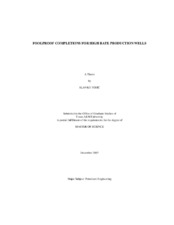| dc.description.abstract | Operators, especially those managing production from deepwater reservoirs, are striving to produce
hydrocarbons at higher and higher rates without exposing the wells to completion failure risk. To avoid
screen failures, recent studies have favored gravel pack (GP) and high rate water pack (HRWP)
completions over high-permeability fracturing (HPF), known in the vernacular as a frac&pack (FP) for
very high rate wells. While a properly designed GP completion may prevent sand production, it does not
stop formation fines migration, and, over time, fines accumulation in the GP will lead to increasing
completion skin. Although, and not always, the skin can be removed by acidizing, it is not practical to
perform repeated acid treatments on deepwater wells, particularly those with subsea wellheads, and the
alternative has been to subject the completion to increasingly high drawdown, accepting a high skin effect.
A far better solution is to use a HPF completion. Of course the execution of a successful HPF is not a
trivial exercise, and frequently, there is a steep learning curve for such a practice.
This work explains the importance to HPF completions of the well trajectory through the interval to be
hydraulically fractured, for production, not execution, reasons. A new model quantifies the effect of the
well inclination on the connectivity between the fracture and the well via perforations. Guidelines based
on the maximum target production rate, including forecasts of multiphase flow, are provided to size the
HPF completion to avoid common completion failures that may result from high fluid rate and/or fines
movement. Skin model will be developed for both vertical and deviated wells. Once the HPF is properly
designed and executed, the operators should end up with a long term low skin good completion quality
well. The well will be safely produced at the maximum flow rates, with no need for well surveillance and
monitoring. | en |


